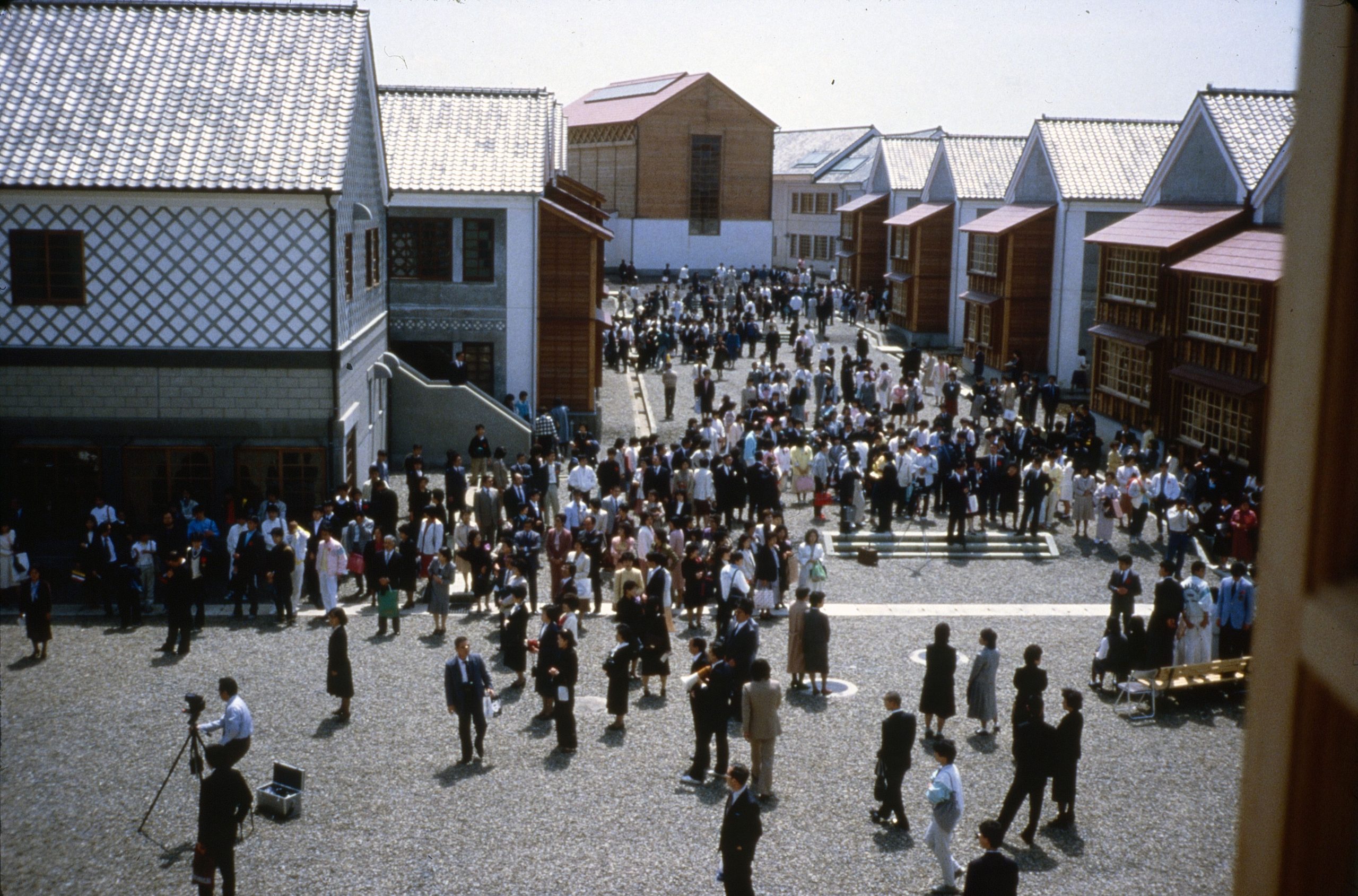
Eishin Campus – High School: Double Homebase Buildings
1982 to 1985The Homebase Buildings form the homebase street. They are two-story masonry buildings with pitched tiled roofs and concrete ornamental wall friezes. Each one has its own garden, with a stair leading to the second floor classrom. There are two double attached homebase buildings, marking the front edge of the homebase street, where it meets the main square.
Contents
-
Eishin Campus - High School: Homeroom buildings wall mockups for testing ornaments
1983
Wall mockups with concrete block, white plaster, black plaster, green plaster, wood, stone in different proportions.
-
Eishin Campus - High School: Ornamental wall frieze for the homeroom buildings
1985
Cast concrete ornaments on the wall frieze of the Homeroom buildings.
-
Eishin Campus - High School: Roof eave detail for the homeroom buildings
1985
Heavy concrete cornice on the Homeroom buildings, when roof meets wall.
-
The Campus of Eishin - High SchooI: Photographs of the pedestrian network of the campus and the main square
01/05/1985
Two views of the main square,next to the water’s edge. The first photo was exhibited at the 14th International Architecture Biennale Exhibition: “Office US”.
-
The Campus of Eishin - High SchooI: Photographs of the pedestrian network of the campus and the Homebase street
01/01/1986
Eight views of the Homebase street, when the construction of the terraces stepping up from the main square with the Great Hall all the way to its end where the Central Building stands was completed. The terraces were formed by ...
-
The Campus of Eishin - High SchooI: The campus in snow - Photographs of the buildings
01/01/1986
Two views of the campus in snow.
SEE ALL Photographs
References
-
Geometry and Fifteen Fundamental Properties
Christopher Alexander recognized the importance of the geometry of centers and for years he was looking for the common structural features among buildings, paintings, streets, carpets, doors, windows, etc. which have "life" and "wholeness". He identified fifteen structural features which ...
-
Ornament and Function as Products of Unfolding
Ornament arises as part of the design process, when a person is making and seeks to embellish this "something" while making it. It arises as a result of the latent centers in the uncompleted thing requiring still more centers, requiring ...
-
Strong Centers in all Levels of Scale
A building can only amount to something as a living thing when the various physical elements which appear in it are profound centers. The dominant feature of the process that is working correctly is that new centers are formed, and ...
SEE ALL Scientific Research
-
The Nature of Order - An Essay on the Art of Building and the Nature of the Universe.
Book Two - The Process of Creating Life
2002
“The Process of Creating Life”, the second volume of “The Nature of Order” series presents a dynamic theory of living structure. It begins with an analysis of transformations, which occur in nature, and the distinction between structure-preserving transformations, responsible for ...
-
The Nature of Order - An Essay on the Art of Building and the Nature of the Universe.
Book Three - A Vision of a Living World
2005
“A Vision of a Living World”, the third volume of “The Nature of Order” series, presents, for the first time, a full spectrum of Alexander’s and CES built and unbuilt works. The book describes hundreds of buildings, plans, neighborhoods, drawings, ...
-
The Battle for the Life and Beauty of the Earth - A Struggle between Two World-Systems
2012
The ninth and last volume of “The Center for Environmental Structure Series” on architecture published by Oxford University Press is the “The Battle for the Life and Beauty of the Earth – A Struggle between Two World-Systems”. The book puts ...
-
The Campus of Eishin- High School: Homeroom buildings walls - Photographs of mock-up
01/01/1983
Five views of experiments and mock-ups for testing distribution of materials, understanding and defining the relative percentage of the different materials used for the walls. Concrete, plaster, wood and tiles were tested in the mock-ups, so that the veriety of ...
-
The Campus of Eishin- High School: Homeroom buildings ornament - Photographs of mock-up
01/01/1983
Image with two C.E.S. members making experiments in the yard at Eishin. They were to become prototypes for ornaments on the homeroom buildings. It was exhibited at the 14th International Architecture Biennale Exhibition: “Office US” in 2014.
-
The Campus of Eishin- High School: Homeroom buildings ornament - Photographs of mock-up
01/01/1983
Ornament mock-up using concrete blocks, primarily used in the homeroom buildings.
SEE ALL Photographs




 Go Back
Go Back